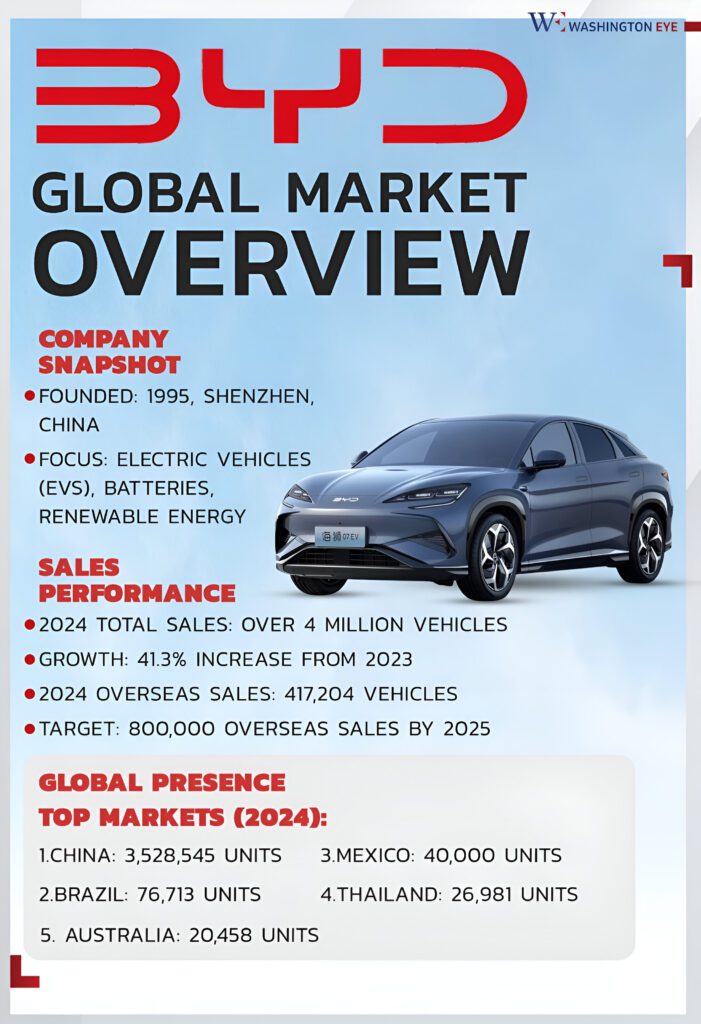In a historic shakeup for the electric vehicle industry, Chinese automaker BYD (Build Your Dreams) has surpassed Tesla in global Electric Vehicle (EV) sales, officially ending Elon Musk’s multi-year reign at the top. The shift signals more than just a sales milestone—it represents the evolving power dynamics in global tech, manufacturing, and sustainability.
The Milestone: BYD’s Overtake
BYD sold 3.02 million fully electric vehicles in 2024, compared to 1.81 million by Tesla, marking a dramatic shift in momentum. While Tesla’s numbers reflect impressive year-on-year growth, they’ve been eclipsed by BYD’s aggressive expansion, strategic pricing, and domestic market dominance.
Home Advantage: China’s EV Ecosystem
BYD’s ascent has been heavily supported by China’s robust EV ecosystem. Aided by state subsidies, abundant raw materials, and lower labor costs, the company has been able to scale rapidly and keep prices highly competitive.
The Japan Times editorial notes that China’s “entire supply chain—from battery production to rare earth processing—is not only vertically integrated but also cost-effective,” allowing BYD to deliver EVs at prices significantly lower than global rivals.
Tesla’s China Conundrum
Tesla, once viewed as the invincible innovator, now faces challenges not just abroad but in China—its second-largest market. In an ironic twist, Tesla’s Shanghai Gigafactory helped kickstart the EV movement in China, but now local rivals like BYD have seized control of the narrative.
Elon Musk finds himself in a delicate situation: expanding operations in a country where a top competitor now outpaces his company in both innovation speed and affordability.
Price Wars and Market Strategy
One of BYD’s greatest advantages has been its ability to undercut prices. Its compact electric sedan, the Seagull, retails for just under $10,000 USD, making it extremely attractive in emerging markets.
In contrast, Tesla’s cheapest model, even after price cuts, remains more than double that price in many regions. Musk’s recent focus has turned to a refreshed Model Y, aimed at reinvigorating sales. But, it’s unclear if a single refreshed model can offset the broader loss in market share.
Going Global: BYD’s International Push
No longer content with domestic dominance, BYD has expanded its footprint in Europe, Southeast Asia, and Latin America. Its international success has been boosted by localized production strategies and partnerships, making it more adaptable to regional consumer preferences.
According to the BBC, BYD’s strategic investments—like building factories in Hungary and expanding into the UK—are part of its broader mission to become a truly global EV brand.
BYD currently operates a growing fleet of car carriers—six in total, with a seventh vessel entering service soon—as part of a strategic move to reinforce its global expansion and secure its supply chain. These vessels, including the massive BYD Shenzhen, which can transport over 9,000 vehicles, are not just a logistical investment but a critical piece of the company’s broader effort to assert itself as a dominant player in the international electric vehicle (EV) market.
The decision to develop and control its own shipping fleet stems largely from recent global supply chain disruptions that impacted automakers worldwide. During the COVID-19 pandemic and the subsequent recovery period, bottlenecks in global shipping created severe delays, especially in the roll-on/roll-off (Ro-Ro) vehicle transport sector. For a company like BYD, which aims to deliver millions of EVs globally and scale quickly in new markets, such unpredictability could cripple growth. Rather than remain dependent on third-party logistics providers, BYD opted for vertical integration—ensuring it could move vehicles reliably and cost-effectively.
This approach also gives BYD a clear cost advantage. By operating its own ships, the company reduces overhead costs associated with freight surcharges, port congestion fees, and leasing. That directly supports its core business model of undercutting rivals like Tesla on price, especially in developing economies. Furthermore, BYD’s ships are designed to be environmentally friendly, operating with dual-fuel systems that align with the company’s sustainability commitments.
Notably, while many EV makers view the U.S. market as a priority, BYD has taken a more measured approach. Stringent tariffs, political tensions, and regulatory obstacles have made U.S. entry less attractive in the short term. Instead, BYD is focusing on regions where the barriers to entry are lower and where demand is accelerating: Europe, Southeast Asia, Latin America, and parts of Africa. These areas offer a combination of rising middle-class demand, government support for electrification, and less competition from entrenched domestic automakers.
In this context, BYD’s car carrier fleet is more than a shipping solution—it’s a symbol of a broader strategy. One that blends production control, logistical independence, and market agility to position the company as a global leader in EVs. The ability to move its vehicles efficiently across continents without being beholden to external disruptions reflects just how far BYD has evolved from a domestic manufacturer into a global mobility powerhouse.
Innovation vs. Iteration
Tesla remains an engineering powerhouse, with a deep bench in software, autonomous driving, and battery tech. But BYD has focused on solid-state battery advancements and hybrid innovations, particularly in areas where EV infrastructure is still growing.
Its “Blade Battery” has received praise for its safety and durability, two features that resonate in both developed and developing markets.
What’s Next: Can Tesla Bounce Back?
Elon Musk’s empire isn’t down for the count. Tesla’s upcoming roadmap includes a lower-cost vehicle, continued global factory expansion, and software innovations in self-driving tech. But the competition has never been fiercer.
Meanwhile, BYD’s founder, Wang Chuanfu, once dismissed by critics, is now hailed as a visionary. His company’s methodical approach has turned them into a quiet juggernaut reshaping the future of mobility.
A Final Note
The EV race is no longer a solo sprint led by Silicon Valley—it’s a complex, global marathon. BYD’s rise is a wake-up call that price, production agility, and policy alignment might now outweigh pure innovation in the battle for global dominance. While Tesla is still part of the game, BYD seems to be setting the pace.





















